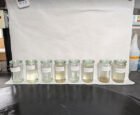Demonstrating science in ways that show the processes and outcomes makes the principles much easier to grasp. For Ashley Waggoner, a soil scientist with the USDA Agricultural Research Service, illustrating how rainfall impacts dairy forage fields is important to understanding erosion, runoff and leaching. Still, even the best field day can’t show what happens with soil on a rainy day.
Simulating rain’s impact
Waggoner works at the U.S. Dairy Forage Research Center in Madison, Wisconsin as the engagement coordinator on the Soil Health Alliance for Research and Engagement (SHARE). She’d been asked to develop a display for the 2024 World Dairy Expo. A rainfall simulator was ideal to show attendees how different soil types, including those treated with manure, respond to rainfall.
The simulators she used are somewhat akin to a fridge water filter: water is poured into the top receptacle, which has perforations in the bottom. As the water flows, it drips onto the soil in patterns similar to rainfall. The soil matter is stored in a tin with perforations. This flows into another receptacle that captures the water that infiltrates through the soil, while a front container captures runoff water from the top of the soil sample. The samples were collected with the help of Landon Baumgartner, an Iowa county-based extension specialist who knew farmers who allowed them to collect two samples each, and displayed in jars at the World Dairy Expo.
Soil health principles and appreciating context
She says the five principles of soil health (maximize biodiversity, maximize cover, maximize living roots, minimize disturbance and incorporate livestock where possible) are all important, but are dependent on the important sixth principle of context.
“Context is going to impact all of those,” says Waggoner, of the principles. “That’s what I was hoping to display, was context. I really wanted to demonstrate how these different principles of soil health can help with the soil.” In perfect conditions, she says the water would flow through the soil, infiltrating into the lower reservoir, remaining clear. In a poor soil health scenario, the water would run off the top and come out muddy in the reservoir.
One sample was from a field with cover crops that had been planted after manure was applied. The second was solid manure applied, the field left fallow. “I’d never done [a rain simulator] with that manure crust still on [the sample],” says Waggoner. “The cover crop will hold the manure [and] the soil in place.”
Both exhibited minimal erosion and cloudiness in the water that ran through the simulator, but knowing why is the key. She’d expected more runoff on the fresh manure sample, but recognizes that the organic matter in solid manure will absorb moisture. However, once the absorption is maximized and the manure begins to break down, the initial assumption of runoff and particles in the soil infiltration will reveal itself.
“That manure, without the cover crop, that manure is going to break down and that protection is going to go away. Then you’ll start to see erosion,” she says. “Any rain that’s happened after that, we would expect erosion like there was no cover.” •















